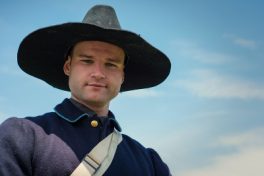

Historic Fort Snelling at Bdote
As many of you know, Senator Mary Kiffmeyer wants to lop $4 million dollars off the budget of the Minnesota Historical Society because the new sign at the Visitors’ Center at Fort Snelling reads: Historic Fort Snelling at Bdote. Bdote is the Dakota word for the “spur of land at the confluence of the Mississippi and Minnesota rivers,” says the Strib’s Jennifer Brooks. Brooks had a column about Kiffmeyer’s act of revenge in the paper edition of the Strib on Friday, April 26th. She includes some choice quotes from Kiffmeyer and a bumbling Senator Scott Newman, too. Newman first:
“The controversy revolves around whether or not the Historical Society is involved in revisionist history,” Newman said. “I do not agree with what the Historical Society is engaged in doing. I believe it to be revisionist history.”
Scotty probably also believes that the earth is flat but that doesn’t make it so.
Fort Snelling was strategically located at, as Brooks says, the confluence of the Mississippi and Minnesota Rivers. It’s where two water routes met, or separated, depending on which direction you were going; the fort was established decades before Minnesota became a state. Bdote is what the Dakota nation called the area for a very long time before Ft. Snelling existed. Early explorers like Zebulon Pike and Henry Schoolcraft were undoubted familiar with the word and what it meant.
Update: As others have observed and reminded me, Mendota, which sits across the Minnesota River from Ft. Snelling, is derived from the Dakota word Bdote.

Impression of Zebulon Pike era soldier – SJT photo
Fort Snelling was one of a string of forts established to check the encroachment of British and Canadian interests along the frontier. It was not an idle concern; there were Northwest Fur Company trading posts near what is now Pine City and at Grand Portage.
Fort Snelling was established as Fort St. Anthony in 1819. Its name was changed to Ft. Snelling shortly after its completion in 1824 to honor its architect and first commander, Col. Josiah Snelling.
If you go to the fort on other than Memorial Day, or one of the commemorative weekends it has (Civil War, WWII, WWI), you will see daily life at the fort in the years shortly after it was completed: thirty years before Minnesota statehood, including civilians, and wives and children of soldiers. You can also see the quarters where Dred Scott and his wife Harriet lived for a time in the late 1830s; their owner was an officer at the fort. The Scott’s residence in Minnesota was one of the bases of their claim for freedom, which as we know, was denied in the case of Scott v. Sanford.
Now, here’s what Sen. Kiffmeyer says about Fort Snelling:
Fort Snelling, she said, should be an unbroken celebration of Minnesota’s military history.
“It is the history of Minnesota. It is military appreciation,” Kiffmeyer said. “Minnesota’s history all the way back to the Civil War and the very first regiments … is deep and strong and long.”
I just recounted forty years of history at Fort Snelling before the Civil War, including one of the causes of it, and mentioned its importance to the indigenous populations for a long time before that. Fort Snelling also responded to – or helped kick off, depending on your point of view – the wars with the Dakota and other Plains Indian tribes that include names like Custer’s Last Stand and Wounded Knee.

Post Civil War Indian wars soldier – SJT photo
Kiffmeyer’s remarks, and Newman’s too, reflect not only obvious racism but stunning pig ignorance as well. [Update: I think it reflects their fragile spirits as well.]
The presentations that you will see at Fort Snelling on Memorial Day and the commemorative weekends, and some of the day-to-day fort portrayals, too, are done by volunteers. Many of them are teachers. I won’t speak for them, but I suspect that a lot of them have a different and broader view of Minnesota’s early history and the role that Historic Fort Snelling plays in illuminating it.
Truculent dimwits and fools like Sens. Kiffmeyer and Newman demean this work. It will be shameful if they have the last word at the Legislature.
Thanks for your feedback. If we like what you have to say, it may appear in a future post of reader reactions.

